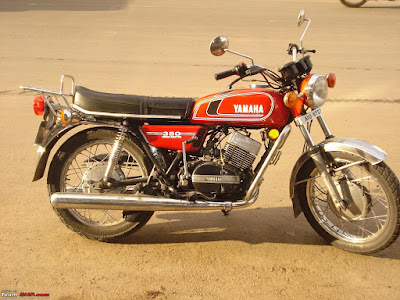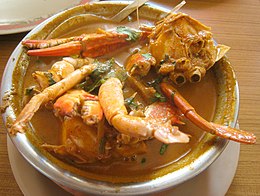The Japanese Mean Machine-RD350
All over the world bikes have always been a
symbol of free-spiritness, independence and adventure. India being highly
populated and a developing country is the largest market in the world of bike
sales has been exposed to a pretty wide band of crotch-rockets. From the Beasty
Enfields to the hooligan RX's and from efficient Honda's to the petrol thirsty
Jawa's.
One
of the brands in India that has ruled Indian streets for longest duration is
Yamaha. With their performance oriented bikes. No other brand could compete
with Yamaha in the 2-Stroke era. Out of all the 2-Stroke bikes of Yamaha the
most under rated was RD series, which has made it a precious bike in these
ages. RD 350 is a dream of every boy right from the first time he hears about
and researhes on Wikipedia about it.
Rajdoot RD 350 HT was first released in India in later half of the year
1983. And issued to Indian cops for their chases, but the bikes were so
powerful (30.5 Bhp)l that cops could'nt control it and often met with an
accident themselves, popping unintensional wheelies and what nots. Even the
fuel economy was'nt acceptable to Indian standards of those days.So slowly cops
started avoiding the RD 350 HT. Which forced Yamaha to move to manufacturing
slightly less powered (27 Bhp) RD 350 LT which was'nt really underpowered, but
somehow provided better economy.
Basic Differences between the HT and LT are
listed below:
·
Sold From September 1983 to
November 1984(upto 1989 for government).
·
RD 350 series never came
with YAMAHA written on the tank.
Now even after it has been over a 3 decades since
the introduction of The RD 350, there have'nt been many bikes in under 400cc
class that can even think competing with with The RD. Except The KTM's RC 390.
A single cylinder 4-Stroke 373.4cc
liquid cooled bike generating a crazy 43Bhp mated with a 6 speed gear box. One of
the most technologically advanced bikes in India yet.
It's really unfair to compare these two
hooligans. But a Parallel twin 2-stroke against a single cylinder modern
4stroke. But even with the disadvantages like Carburetor to supply fuel, and
excessive weight of the Kick Start Assembly, The veteran RD 350 does'nt give up
against the young and upcoming RC 390.
Due to the exhasut norms all around the world
2-stroke days are long gone and now it the time for 4-stroke to shine.
all the credits for this info@
goes to my dear Friend
Mr.Rohan Bhujle
+91-890 466 6814
rohan.bhujle@gmail.com
https://www.facebook.com/Rohan.Bhujle
Just on my one request he has given me so much info that too in is busy shedule!! Thank You rohan!! :)
videos@
check out here> www.youtube.com/watch?v=pYfWs49Thr8
All over the world bikes have always been a
symbol of free-spiritness, independence and adventure. India being highly
populated and a developing country is the largest market in the world of bike
sales has been exposed to a pretty wide band of crotch-rockets. From the Beasty
Enfields to the hooligan RX's and from efficient Honda's to the petrol thirsty
Jawa's.
One
of the brands in India that has ruled Indian streets for longest duration is
Yamaha. With their performance oriented bikes. No other brand could compete
with Yamaha in the 2-Stroke era. Out of all the 2-Stroke bikes of Yamaha the
most under rated was RD series, which has made it a precious bike in these
ages. RD 350 is a dream of every boy right from the first time he hears about
and researhes on Wikipedia about it.
Rajdoot RD 350 HT was first released in India in later half of the year
1983. And issued to Indian cops for their chases, but the bikes were so
powerful (30.5 Bhp)l that cops could'nt control it and often met with an
accident themselves, popping unintensional wheelies and what nots. Even the
fuel economy was'nt acceptable to Indian standards of those days.So slowly cops
started avoiding the RD 350 HT. Which forced Yamaha to move to manufacturing
slightly less powered (27 Bhp) RD 350 LT which was'nt really underpowered, but
somehow provided better economy.
all the credits for this info@
rohan.bhujle@gmail.com
https://www.facebook.com/Rohan.Bhujle
Basic Differences between the HT and LT are
listed below:
Note:Numbers and inscriptions are to b checked on
the bike and body, not the RC book.
(HT)High Torque:
·
Sold From September 1983 to
November 1984(upto 1989 for government).
· Engine Number Starts from
IAI.51.XXXX(XXXX=66->2048).
·
Approximately 2200 were
made.
·
HT on the left side view has
347cc engraved on it.
·
HT has 140 sized main jets.
·
Head And Block has nearly
1.5cm of gap in between.
·
Silencers Are Flat
Throughout.
·
Obviously Roars Louder.
·
Power Band is lies between
4500->7000/7500 rpm.
·
Maximum Output 30.5 Bhp @
6750 rpm.(LT)Low Torque
·
Sold From November 1985 to
1989(1989-.
·
Engine Numbers begin with
00XXXX(XXXX->Digits).
·
LT Block in Left Side View
has RAJDOOT 350 engraved on it.
·
LT has 110 sized main jets.
·
Head And Block has nearly
1.5cm of gap in between.
·
Silencer End Taperingly.
·
Roar Is Supressed.
·
Power Band Lies Between
2750/3000 -> 6000 rpm.
·
Maximum output of 27 Bhp.
·
RD 350 series never came
with YAMAHA written on the tank.
·
RD does'nt stand for RajDoot
as assumed by many, not Rapid Death as coined by the cops unfit to ride and
deifnitely not Racer's Delight, although
both the titles are totally justifiable.
Now even after it has been over a 3 decades since
the introduction of The RD 350, there have'nt been many bikes in under 400cc
class that can even think competing with with The RD. Except The KTM's RC 390.
A single cylinder 4-Stroke 373.4cc
liquid cooled bike generating a crazy 43Bhp mated with a 6 speed gear box. One of
the most technologically advanced bikes in India yet.
It's really unfair to compare these two
hooligans. But a Parallel twin 2-stroke against a single cylinder modern
4stroke. But even with the disadvantages like Carburetor to supply fuel, and
excessive weight of the Kick Start Assembly, The veteran RD 350 does'nt give up
against the young and upcoming RC 390.
Due to the exhasut norms all around the world
2-stroke days are long gone and now it the time for 4-stroke to shine.
all the credits for this info@
goes to my dear Friend
Mr.Rohan Bhujle
+91-890 466 6814
rohan.bhujle@gmail.com
https://www.facebook.com/Rohan.Bhujle
Just on my one request he has given me so much info that too in is busy shedule!! Thank You rohan!! :)
videos@
check out here> www.youtube.com/watch?v=pYfWs49Thr8
check out here> www.youtube.com/watch?v=pYfWs49Thr8























